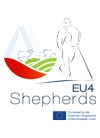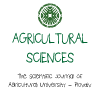Applied animal feeding
|
Course title: |
Applied Animal Feeding |
|
|
Course code: |
AFAAF |
|
|
ECTS: |
5 |
|
|
In-class hours |
Lectures: |
30 |
|
Laboratory work/Tutorials: |
30 |
|
|
Self-preparation hours |
Practical training: |
15 |
|
Other: |
50 |
|
|
Total hours: |
125 |
|
|
Language: |
English |
|
|
Study cycle: |
Bachelor |
|
|
Semester: |
Winter |
|
|
Faculty: |
Faculty of Agronomy |
|
|
Name of the lecturer(s): |
Prof. Dimo Penkov, PhD, Dr.Sci. |
|
|
Mode of delivery: |
Face-to-face |
|
|
Prerequisites: |
Principles of Animal Nutrition and Forage Crop Production |
|
|
Learning outcomes of the course unit: |
The object of this course is the study of: 1. Nutritional values of the forages, methods for forage production and conservation, principles of their feeding, and management 2. Composition of rations and combined foods for different species and categories of domestic animals. Learning Outcomes: The students will be knowledgeable in: 1. Preparing and conservation of different forages (silages, hay, energy and protein fodders, wastes from the food- and beverly (хранително – вкусова) industry, methods for treating of fodders, before feeding, principles of preparing of combined fodders. 2. Practical feeding of the domestic animals – preparing of rations, the composition of combined fodders, a nutritional regime for the different animal species. The students will utilize the acquired knowledge in their further education for: ® Management of the forages and the forage producing; ® Balancing the feeding ratios of different domestic and avian species according to their physiological and productive characteristics. |
|
|
Course contents: |
Lectures – 30 hours
1. Forages and forage additives. Forage classification by different criteria. International classification of the forages. Grass forages. Intensive grass – species. Meadows and pastures – maintenance, using, management. Feed quantities for the different animals - 2 hours 2. Hay – preparing. Ascending factors on water evaporation – hay quality. Hay deposition, using for feeding of different animals, nutritive values, requirements of feeding. Artificial dehydrated fodders. Low energy wastes – fodders- methods for increasing their energy nutrition values. Silages. Conditions and silage – techniques. Raw stuff for silages. Kinds of silages. Quantity estimation – 2 hours 3. Energy fodders - cereals. Protein fodders. Treatments before feeding. Wastes fodder – from the flour-mills, sugar – extraction industry, winery, brewing, food and beverly industry \хранително – вкусова промишленост). Nutritive values, methods of feeding – 2 hours 4. Waste from vegetable oil-producing. Fodders with animal origin, bacteria origin, synthetic fodders., forage feeds, Nutritive values and methods of feeding – 2 hours 5. Forage additives. Non-protein N- compound. Synthetic amino - acids. Mineral and vitamins – additives. Coccidiostatics and antibiotics. Probiotics. Antioxidants, emulgators, enzymes – 2 hours 6. Combined fodders. Raw materials for combined fodders. Classification. Technological processes. Quality control. Regulation of the trading - 2 hours 7. Cattle–feeding. Feed formulation. Rations formulation. Practical feeding of dairy cattle. Management of the feeding. Feeding of young breeding beef and cattle -2 hours 8. Practical feeding of meat – cattle breeds. Fattening of beef. Feeding of different categories buffalos – 2 hours 9. Practical feeding of sheep and goats- pregnant, milking, young animals for breeding and fattening – 2 hours 10. Practical feeding of adult male breeding animals (bulls, rams etc.) – 2 hours 11. Feeding of different categories of horses. Fodders and fodder consumption – 2 hours 12. Feeding of different categories of swine. Nutrient requirements. Fodders and fodder consumption – 2 hours 13. Feeding of different categories of hen. Combined fodders for them – preparing and practical feeding. Feeding for egg – production for consumption and incubation. Feeding of young breeders. Fattening of broilers. Feeding of different categories of turkeys – 2 hours 14. Feeding of different species and categories of waterfowl. Feeding of guinea-fowls, pheasants, Japanese quails – 2 hours 15. Feeding of different categories of rabbits (cuniculas). Feeding of wild animals – 2 hours
Practical exercises - 26 hours
1. Sensuality estimation of hay and silages – 2 hours 2. Principles of rations and combined foods – composition – 2 hours 3. Composition of rations for dairy cows and pregnant non – milking cows – 2 hours 4. Composition of rations for young cattle for breeding and fattening – 2 hours 5. Composition of rations for bulls and meat – cattle races – 2 hours 6. Composition of rations for different categories sheep and goats – 2 hours 7. Principles for fodder balance – composition. Formulation of individual projects - 2 hours 8. Composition of rations for different categories of horses – 2 hours 9. Composition and balancing of combined fodders for different categories of swine – 2 hours 10. Composition and balancing of combined fodders for different categories avian – egg-laying hen, young chicken for breeding and fattening – 2 hours 11. Composition and balancing of combined fodders for different categories avian- turkeys, geese, ducks – 2 hours 12. Composition and balancing of combined fodders for different categories rabbits (cunicula) – 2 hours 13. Composition of rations for swine and rabbits in the small farming – 2 hours
Seminars 14. Fodder balance in farms – 2 hours 15. Continuation of (14) -– 2 hours
|
|
|
Recommended or required reading: |
1. Nutrition of the Animals, N. Tododrov, A. Ilchev, V. Georgieva, D. Girginov, D. Djuvinov, D. Penkov, Z. Shindarska, 2004, Con-Car - Sofia (311pp, BG) 2.Ensminger, M. E. J. Oldfield, W. Heinemann, 1990, Feeds and Nutrition, Ensminger Ed., LA, 1240pp 3. ARC, 1981, The nutrient requirements of pigs, Commonwealth Agricultural Bureaux, Farnham Royal, England 4. ARC, 1984, The nutrient requirements of ruminant livestock, Supplement 1, Commonwealth Agricultural Bureaux, Farnham Royal, England 5. NRC, 1994, Nutrient requirements of poultry, 9-th rev. Ed., NAP, Washington 6. NRC, 1989, Nutrient requirements of dairy cattle, 6-th rev. ed. NAP, Washington, DC 7. NRC, 1999, Nutrient requirements of domestic animals, Nutrient requirements of swine, Wash. DC |
|
|
Planned learning activities and teaching methods: |
Lecture, presentation, briefing, tutorials Dialogue methods (conversation, discussion, brainstorming) |
|
|
Assessment methods and criteria: |
Forms of self – training (non- auditoria’s work)
EDUCATIONAL PRAXIS - 15 hours The praxis will be hold in the fields of teaching-experimental base – the students take part by the preparing of hay, feeding of the animals and birds, ect.
Individual project - 35 hours for preparation The students become their individual projects after exercise 6. The volume of the presentation – 5-8 pages (mostly tables and figures) – 5-10 minutes presentation during the seminars (with discussion)
Format of the individual assignment:
Prepare forage balance in a farm with ….. dairy cows (with the young cattle for breeding (fattening), sheep (goats), : The dairy cattle are with live weight …… kg, daily milk yield….. l, protein/fat in the milk……%. The daily growth of the young cattle is: breeding animals… kg, animals for fattening- …. kg, the final live – weight for the fattened animals is……. kg 1. Formulate basic rations for all categories in the farm (for summer and winter springtime, fall) 2. Calculate the quantities of needed fodders – for different seasons and for the whole year.
SELF - TRAINING FOR THE TESTS DURING THE SEMESTER AND THE EXAMINATIONS - 30 hours
All students are required to be present during all lectures. No credit will be given without participating in class! Two auditoriums and a research base in the Department of Animal Sciences will be used for practical training. The students will work on an individual basis under the supervision of the academic advisor so that the best possible learning outcomes are ensured. The seminars consist of each student’s individual 5 – 10 min presentation and a discussion. The presentation topics will be given in advance. After each practical exercise, the students become individual tasks (composition ratio, combined fodder etc.). At the end of the semester, a practical exam will be held. The final grade will consist of the practical final exam – 25%, the individual project – 25%, and the final theory exam – 50%. If the student receives a grade of 2 in any of the first two components of the final grade, the student will not be allowed to the final theory exam and will fail the class. The final theory exam is in written form. |
|
 - Събития по случай 80-я юбилей на АУ
- Събития по случай 80-я юбилей на АУ











